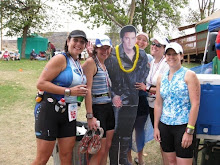Elite runners often say that their ability to push through excruciating bouts of discomfort is integral to their race performance. "After you've built up your base mileage, it's really about how much pain you can take," says Barton, who once ran five 100-mile races within six weeks. "You have to reach into yourself and find that toughness."
As runners propel themselves forward, some measure of discomfort is normal (provided it's not a sign of a serious issue). Muscles burn. Joints ache. Exhaustion sets in. However, research suggests that our pain threshold is not set at an unmovable level—that the mind can, to some extent, control it. "When I tell an athlete that they can adjust their pain level by using mental techniques, they're amazed," says Raymond J. Petras, Ph. D., a sports psychologist in Scottsdale, Arizona. "They often find that their performance increases dramatically." The following mental tricks—recommended by sports psychologists and used by elite runners—will help you redefine your limits.
The Pain: Feeling Sick in Anticipation of a Run
Deal With It: Remember Your StrengthsResearchers at the University of Illinois recently reported that athletes who believed they could tolerate leg-muscle pain performed better in a running test than those who doubted their ability to withstand pain. "Think of all the other challenging workouts and races you've done to remind yourself of how strong and capable you are," says sports psychology consultant and marathoner Kay Porter, Ph. D., of Eugene, Oregon.
The Pain: Struggling Through Mile Repeats
Deal With It: Run With PurposeDon't dwell on how much you hurt. Rather, focus on your rationale for training. "Tell yourself, 'I'm working this hard because...' and then fill in your performance goal," says Jim Taylor, Ph. D., a performance psychologist and sub-three-hour marathoner in San Francisco.
The Pain: Climbing a ?@*#! Mountain
Deal With it:Repeat a Mantra"If you connect pain with a negative emotion, you'll feel more pain," says Taylor. "Connect it with a positive thought, and you'll feel less." Create a positive affirmation you can call upon during tough bouts. It worked for Matt Gabrielson, who repeated "Go!" and "Do this now!" while racing the 2008 USA Marathon Championship and the 2008 Twin Cities Marathon — he placed second at both.
The Pain: Hitting a Low
Deal With It: Know It Will PassSeasoned runners like Barton know that pain not related to an injury is often fleeting, and this knowledge is sometimes enough to help ride out the unpleasantness. "I learned that the pain comes and goes, and so at future races I was ready for it," she says. "I could take it because I knew what to expect." During difficult moments, put the pain in perspective. Remind yourself that the discomfort is temporary, and each step forward is one closer to the finish. Research has even shown that pain is often purely in your head and not an accurate signal of physical distress. Keeping this in mind will enable you to push through the discomfort so you can run faster or longer.
The Pain: Long-Run Fatigue
Deal With It: Think of the Payoff"Don't get too emotionally involved with the pain or get upset when you feel it," Taylor says. "Detach yourself and simply use it as information." Ask yourself where the pain is and why it's happening. And if it's not related to an injury, then acknowledge that this could be an indication that what you're doing is going to help you reach your goal. "Some types of pain tell you that you're pushing yourself, that you're getting better," he says.
The Pain: Gutting out a Hard Patch
Deal With It: Distract Yourself"Focus on something else while also staying in the moment," says Gabrielson. At mile 18 of the 2006 New York City Marathon, Gabrielson felt a pounding in his quadriceps. "I had to find a way to channel the pain," he says. His solution? As he ran, he studied the faces of the people on the sidelines. Most of them, he recalls, were smiling, cheering him on. Focusing on the pleasure of others around him was just enough to take the edge off and help him reach the finish line in 2:19:53.
Stop Right There
Running your best often means going all out, but certain pains are warning signs you shouldn't ignore.Sharp, sudden foot, shin, or hip pain that worsens as you run
It's possible you have a stress fracture, says Heather Gillespie, M. D., a sports-medicine physician at UCLA. Take time oft from running and make an appointment for an x-ray.
Limping
This could be the result of a muscle or ligament tear. "Any pain that causes you to change your form should make you stop," says Lewis G. Maharam, M. D., medical director of the New York Road Runners.
Chest pain, extreme sweating, breathlessness
These are symptoms of a heart attack, says William Roberts, M. D., medical director of the Twin Cities Marathon.
High body temperature; dry skin; vomiting
This could be heatstroke, which can be life threatening, says Dr. Gillespie.
Severe stomach pain; diarrhea
These are signs of an intestinal problem called ischemic colitis, which tends to occur during prolonged exercise.
—Nicole Falcone





















No comments:
Post a Comment